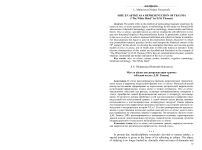Mise en abyme as a representation of trauma (“The white hotel” by D. M. Thomas)
Автор: Muravieva Larissa
Журнал: Новый филологический вестник @slovorggu
Рубрика: Теория литературы
Статья в выпуске: 4 (39), 2016 года.
Бесплатный доступ
The article refers to the problem of representing traumatic experience by means of mise en abyme narrative figure. A methodology for this study was formed at the intersection of rhetorical narratology, cognitive narratology, trauma studies and literary theory. Mise en abyme, specially known as a device creating the self-reflexivity in text, gets new functional impulse in the postmodernist fiction. In particularly, authors resort to the mise en abyme in order to represent individual and collective trauma in narrative. For what purposes this figure is used in the postmodern literary discourse? In which way postmodern narrative practices involve and interpret the historical context of the 20th century? In this article, we develop the assumption that there exist several special models of mise en abyme, one of which aims to reflect the trauma in narrative. Some relevant characteristics of this model are described and illustrated on the example of “The White Hotel” by D.M. Thomas (1981), they are compositional structure; semantic relations; intermedial and modal realization of the mise en abyme.
Mise en abyme, trauma studies, narrative, cognitive narratology, rhetorical narratology, "the white hotel"
Короткий адрес: https://sciup.org/14914580
IDR: 14914580
Список литературы Mise en abyme as a representation of trauma (“The white hotel” by D. M. Thomas)
- Santner E. History beyond the Pleasure Principle: Thoughts on the Representation of Trauma//Probing the Limits of Representation: Nazism and the Final Solution/ed. by S. Friedländer. Cambridge, Mass., 1992. P. 143-154
- LaCapra D. Writing History, Writing Trauma. Baltimore, 2001
- Felman S. Writing and Madness: Literature/Philosophy/Psychoanalysis. Stanford, California, 2003
- Caruth C. Unclaimed Experience: Trauma, Narrative, and History. Baltimore, 1996
- Fludernik M. An Introduction to Narratology. New York, 2009
- Herman D. Story Logic: Problems and Possibilities of Narrative. Lincoln, 2002
- Ryan M.-L. Toward a Definition of Narrative//The Cambridge Companion to Narrative/ed. by D. Herman. Cambridge, UK, 2007. P. 22-35
- Schiffrin D. In Other Words: Variation in Reference and Narrative. Cambridge, UK, 2006
- Schaeffer J.-M. Le traîtement cognitive de la narration//Narratologies contemporaines. Approches nouvelles pour la théorie et l’analyse du récit/J. Pier et F. Berthelot (dir.). Paris, 2010. P. 215-231
- Derrida J. La structure, le signe et le jeu dans le discours des sciences humaines//Derrida J. L’écriture et la différance. Paris, 1967. P. 409-429
- Dällenbach L. Le récit spéculaire: Essai sur la mise en abyme. Paris, 1977
- Калинин И. Историчность травматического опыта: рутина, революция, репрезентация//Новое литературное обозрение. 2013. № 6. С. 18-34
- Sarraute N. L'Ère du soupçon, essais sur le roman. Paris, 1956. P. 82
- Липовецкий М.Н. Паралогии: трансформации (пост)модернистского дискурса в русской культуре 1920-2000-х годов. М., 2008. С. 73
- Яропольский Г. Постояльцы отеля «Вечность» (Заметки на полях перевода)//Томас Д.М. Белый отель. СПб., 2014. С. 305-317
- Thomas D.M. The White Hotel . . London, 1981. Р. 28-29
- Thomas D.M. The White Hotel . . London, 1981. Р. 43
- Яропольский Г. Постояльцы отеля «Вечность» (Заметки на полях перевода)//Томас Д.М. Белый отель. СПб., 2014. С. 306
- Eco U. The Role of the Reader: Explorations in the Semiotics of Texts. Bloomington, 1979


